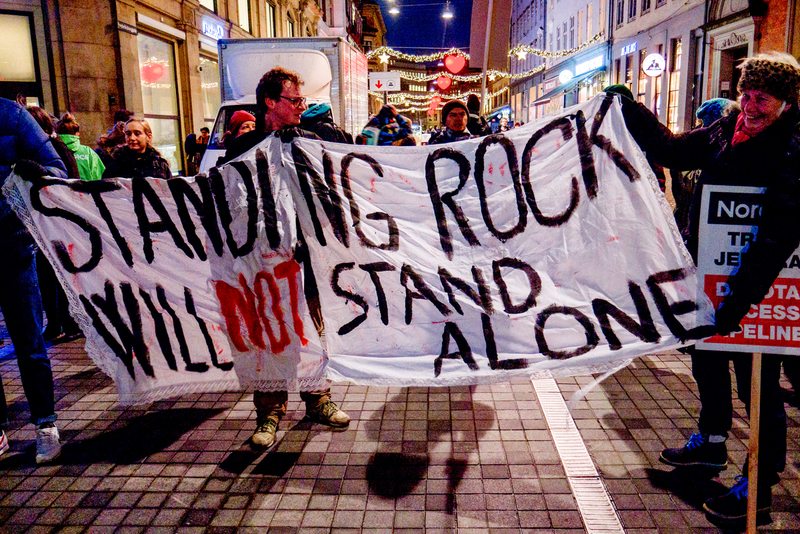“Thank you for calling Greenpeace. This is Diamond, how can I help you?”
I say that line roughly 100 times a day. If you’ve called us to ask a question about Greenpeace or seek advice on how to contribute to the environmental movement, chances are you’ve probably spoken to me. As a supporter care representative, it’s my job to not only answer all incoming calls to Greenpeace, but do whatever I can to help the person on the other line.
Every day, my coworkers and I spend a great deal of time having amazing conversations with Greenpeace supporters all across the world.
The topics of conversation include everything from our brave colleagues and allies who dropped the ‘RESIST’ banner over the White House to the serious threat the Dakota Access Pipeline (DAPL) poses to our environment and Indigenous sovereignty.
Through the course of speaking to hundreds of people about DAPL — especially about how to show solidarity with the Indigenous water protectors leading the movement against it — I’ve learned a few important lessons.
Even before coming to Greenpeace, I have my mother to thank for exposing me to the issues facing American Indigenous communities today.
When I was 16 years old I wanted to work at an ice cream parlor. Unfortunately, my mother couldn’t have disagreed more and instead “suggested” (do parents ever really make suggestions?) that I go to work with her at Indian Health Service. At her insistence, I gave up daily access to coffee ice cream for the opportunity to learn directly from Indigenous communities in ways that most non-Native folks are never exposed to.
I’ve tried before to express how my four years at IHS shaped me and have failed miserably. It feels far too cliche to say that it changed my life and molded me into the person I am today but that’s the truth. IHS was by no means a perfect institution, but my time there gave me an opportunity to learn from Indigenous communities that I wouldn’t have had otherwise.
It’s because of the mistreatment of those same communities by our government that I’m compelled to be an ally in the fight for Indigenous sovereignty now.
It was upon seeing the growth of the #NoDAPL movement that I felt myself missing all those people I had worked with and all those communities I had been in touch with years before. I wondered where they were, how life had been treating them and if they were going to Standing Rock to stand in solidarity with the water protectors. I felt a pull to go and join them myself but after discussing it with my family, I knew that I wouldn’t be able to leave them or my work for that long.
I was left thinking about how I could help. What could I do from Washington, DC to support them and make an impact?
Instead of answers, I first found myself going down the list of all the things I couldn’t do. I couldn’t climb a building and drop a banner, I couldn’t afford monthly donations to an organization, and so on.
But after beating myself down, I realized that there was still so much I could do.
I started by getting on social media. I already spend a good chunk of my day scrolling through Twitter and Instagram, so I just shifted my focus.
I looked for activists in my area who use their platforms to advocate for their communities and spread information about how to get involved. That led me to contact coworkers who were involved in campaign work and ask them for advice on how to participate within my means.
I essentially took all of the tools I would recommend to anyone calling our organization and used them myself.
And that’s what led me to today’s Native Nations March.
Today I watched with admiration as the Standing Rock Sioux Tribe and other Indigenous communities came Native together for the Native Nations March in Washington, DC (and in cities across the country). I watched as my friends, family, and coworkers rose up to voice our opposition to this pipeline, its threat to clean water, and its blatant disregard of tribal sovereignty.
By marching in solidarity, we will be adding our voices to the thousands already speaking out against the pipeline. And perhaps most importantly, we’ll be sending a clear message to Donald Trump that when his administration threatens Indigenous communities, we will all rise up to stop him.
Check out scenes from today’s marches online at #NativeNationsRise — and don’t forget to join one yourself! Find your nearest march at http://nativenationsrise.org/. Here’s what it looked like in DC today:
Today's #SignOfResistance, via @doyoucopyover, is in solidarity with our sisters & brothers rising at the #NativeNationsMarch on Washington. pic.twitter.com/BX2WMTMqUP
— Women's March (@womensmarch) March 10, 2017
Today, Standing Rock Sioux lead #NODAPL protests in DC. Stand in solidarity, amplify outrage, call your reps, follow at #NativeNationsRise. pic.twitter.com/YDLfcBFWnl
— Ava DuVernay (@ava) March 10, 2017
I listened to @lsarsour when she said "follow women of color for they are the moral compass of the nation" #NativeNationsRise #WaterIsLife pic.twitter.com/RNGpb8Xwdg
— Irtefa B-F (@IrtefaBF) March 10, 2017

© Greenpeace
Diamond Coleman is a Supporter Care Representative with Greenpeace USA with a passion for social justice and independent bookstores.


